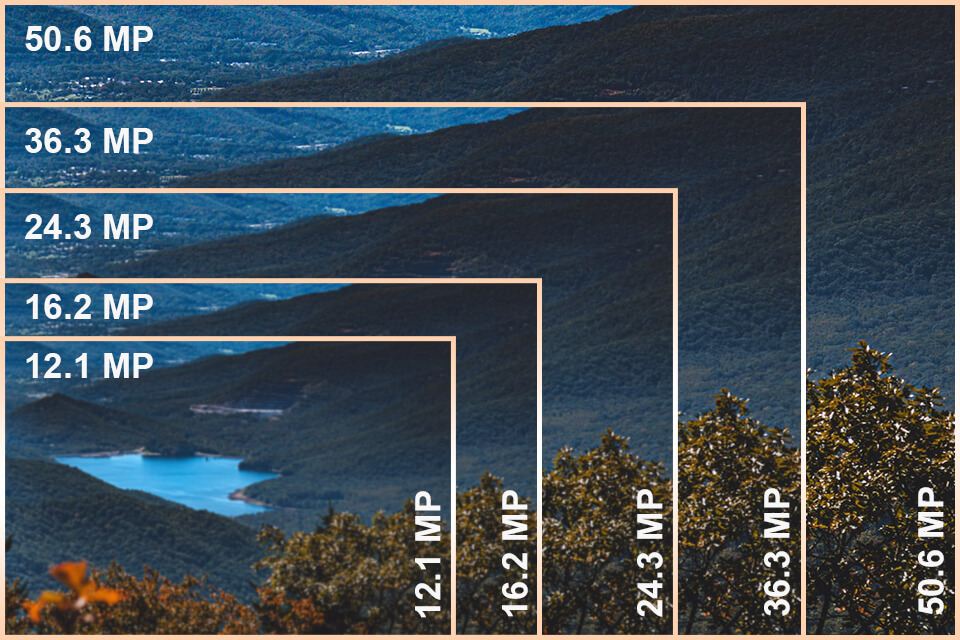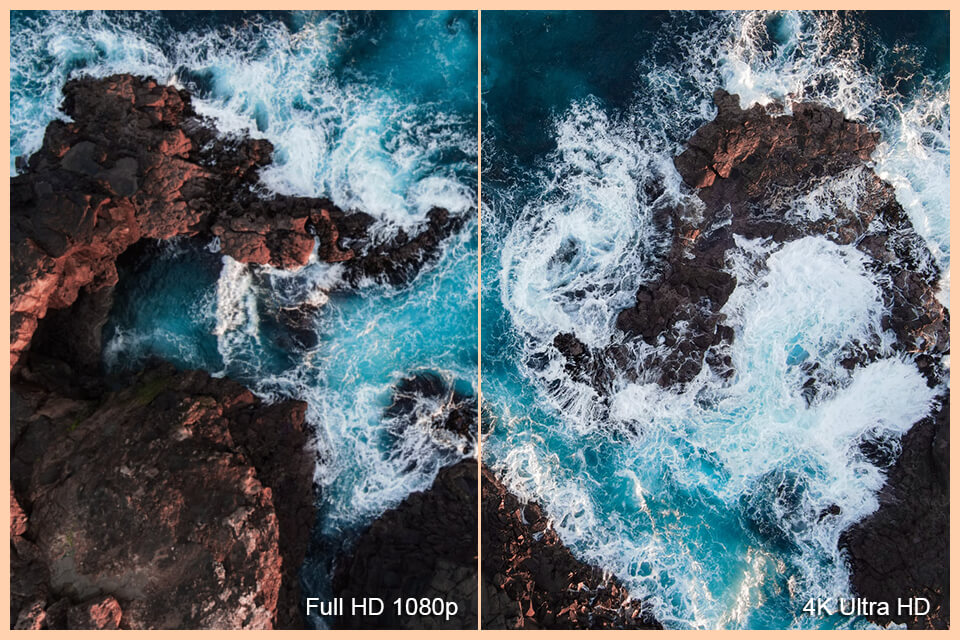- Tips & Tricks
- May 12, 2022
How Many Megapixels Do You Need?

With cameras sporting 100 megapixels (MP) or even more these days, did you ever miss those days when a 2MP camera was considered a treasure? If cameras today can capture high-quality images of the moon, imagine the possibilities with an additional 200, 300, or even 1000 megapixels.
That would mean being able to take even higher-quality pictures from afar. It also means that you can zoom in on an image as much as you want and it won’t get pixelated or blurry.
That said, how many megapixels do you actually need?
Defining Megapixels
You may have heard the word “pixelated” used to describe a digital image that gets fuzzy when you try to zoom in on it. You will see a picture made up of these tiny squares of color.
Each of these squares is called a pixel, and there are millions of them in a single digital image. It is the smallest piece of an image that can be seen.
Pixels are also used in describing a camera’s resolution. For example, the Fuji X-T4 can be set to shoot an image with the size of 6240 x 4160, meaning 6240 pixels long and 4160 pixels wide. The total pixels of the camera is 25,958,400, a number that is too high and hard to remember when asked.
This is why the term megapixels was created, which means a million pixels. So when asked about the pixels of Fuji X-T4, you can simply say it’s 26 MP.
A digital image is like a canvas composed of many pieces of a mosaic or puzzle put together. The higher the pixel count in an image, the higher its resolution is.
Pixels and megapixels are counted per inch. A camera sensor has pixels, which pertain to the sensor’s photosites. What are photosites? They are solo sensing areas responsible for capturing light. Once captured, the image goes through software where the light translates into pixels.
So when you have a camera with a 12 MP camera sensor, the image it can produce has a resolution of 12 million pixels per inch (PPI). This gives its pictures more MPs per inch than an 8 MP camera sensor, which can only produce a resolution of 8 million PPI.
However, a higher MP doesn’t always ensure a clearer output. Image quality will still depend on various factors aside from the camera’s MP, including detail optimization, light sensitivity, and colors.
It’s typical to factor in a camera’s megapixels when viewing a zoomed image or cropping it. In most cases, the pixels will be more evident on an image taken from a 16MP camera compared to a 108MP smartphone camera when zoomed in.
It’s also common for an image with a higher MP count to have a larger file size. This has prompted companies to use pixel binning technology which combines pixels to create a bigger pixel size. As a result, the MP number decreases, the image size reduces, but the image does not show any visible quality loss.
How Many Megapixels Do You Need?
If you have a phone with a 12 MP camera and think about upgrading it to something with a higher camera resolution, think again. What’s the problem with a 12 MP camera? Nothing unless you’re a professional photographer or want to take a closer look at the moon’s surface using your phone’s camera, 12 MP is more than sufficient.
How come? It’s the ideal resolution for the camera sensors of smartphones. Did it ever occur to you how come the big guns in the smartphone industry, such as Xiaomi and Apple, still offer devices with 12 MP cameras? While the 108 MP primary sensors are gradually being introduced and 40 MP camera phones are becoming more common, 12 MP remains the ideal resolution.
The reason for this is simple – you will need more data if you want more pixels. Higher pixels also affect the performance of the camera app and the phone’s battery life.
If you are taking full-resolution images, your phone will require more data since you’re using more pixels. It will result in shorter battery life and slower processing time. This will become more evident when you take shots in Portrait Mode, Night Mode, and other demanding scenarios that require more processing.
This is why it is usual to find phones with superior camera resolutions that do not offer advanced modes when using full-resolution in capturing images or video. Higher resolution needs more bandwidth and more storage.
The introduction of cloud storage may have addressed this as a backup method to using microSD cards. However, you might find it hard to upload several snaps at once if you have a low data cap, especially when you don’t have access to Wi-Fi. Cloud storage also requires additional payment if you want to increase the storage cap.
Besides, the ultra high MPs won’t matter if you don’t view the image or video on Ultra HD displays. But even if you do, most of these displays have a ~8.3 MP canvas setting. This means that a 12 MP image or video will still look good even if you view it on computers, digital photo frames, phones, projectors, or TV. You will only notice the difference when you zoom in while viewing on an Ultra HD display.
When it comes to video resolution, the most popular these days caps out at ~8.3 MP. As long as your phone can shoot 4K, you don’t need a resolution higher than 10 MP. So if you have a 12 MP phone camera resolution, it is more than enough for a 720p at 60 fps or UHD 4K at 30 fps. For a while now, the standard in smartphones for video is 4K Ultra HD, which is roughly 8.3 megapixels.

Snapdragon 888 and Snapdragon 865 introduced the 8K video recording. Do you need it? First, this requirement needs a 33 MP camera sensor or higher. The feature is only handy when grabbing HD frames from a recorded clip.
But the 8K displays do not come cheap and require bigger storage despite the existence of codecs that can shrink down the file sizes. This means that it may not be practical as it only affects video quality.
Pixels are not everything for cameras; the end result will still vary depending on user experience, image processing, lens quality, color accuracy, and dynamic range.
Questions to Ask Before Upgrading to Cameras with Higher MPs
There are only two questions to ask to determine your requirement – what’s your final output, and how much do you have to crop?
1. How much do you need to crop?
There are certain cases when cropping cannot be avoided. For example, you will typically crop in macro photography since the image’s size is limited by the macro lens’ maximum magnification. You can use the feature in background photo editing. Cropping also comes in handy for wildlife photographers when they need to focus on a subject that is quite hard to get close to.
If you require substantial cropping due to the nature of your work or how you often use the camera, it will help to get devices with higher MPs. For example, a Canon R5 with 45 MP resolution can give more choices for printing. If you cropped 1.5x, you would still have 20 MP from your Canon R5’s 45 MP. If you use a camera with a lower resolution, like a Canon R6 with 20 MP, your image will only have an 8.9 MP after cropping.
2. What is your final outcome?
You don’t need ultra-high MPs if you only often display your images on the internet. You can view 8.3 MP video on a 4K monitor. However, it’s important to note that 8K monitors are now becoming more common, which need 33.2 MP. If you plan to make 8K desktop backgrounds in the near future, you may want to consider cameras with 33 MP resolution.
The number of megapixels also contributes to printing high-quality images. Here’s a look at how many MPs you need depending on the size of what you will print:
- Print size 32 x 48 – 5760 x 8640 resolution, 50 MP, 180 PPI
- Print size 24 x 36 – 4800 x 7200 resolution, 34.6 MP, 200 PPI
- Print size 16 x 24 – 3520 x 5280 resolution, 18.6 MP, 220 PPI
- Print size 12 x 18 – 3120 x 4680 resolution, 14.6 MP, 260 PPI
- Print size 8 x 10 – 2400 x 3000 resolution, 72 MP, 300 PPI
The resolution used in printing photos varies on the preference of the photographer. For example, a person’s face with a low resolution will look better when printed than an image with too many details and the same resolution.
Effective Pixels versus Total Pixels
Have you paid attention to the manual of your camera or phone? Almost all of them include two varied values of the MP count – effective MP and total or actual MP. For photographers, you have to pay attention to the effective MPs or the resolution of the image when you shoot in full-size.
What’s the difference between both of them?
Let’s have a brief overview of how sensors work first. Basically, image sensors contain tons of tiny sensors responsible for collecting photons which are then converted to electrical charges via a photodiode. Each photodiode is tied to a single pixel.
In essence, effective pixels capture the data of an image and produce the intended result when taking a picture. For example, a 12MP camera with a conventional sensor will have roughly 11.9MP of effective pixels, which means that the effective pixels are the area of the sensor which are covered by the working pixels.
On the other hand, actual or total pixels include the remaining percentage of pixels that were left over once the effective pixels have been counted. They are mainly used for providing color information and are used as a reference point for reducing noise, especially on long exposure shots.
Long story short, effective pixels capture incoming light, so they’re the only ones that will make it to the final image. Meanwhile, total pixels won’t be recorded at all but will instead play a key role in enhancing the overall quality of the final image.
The Best Photo Editing Apps
While there is a surge of editing apps online, there are still times when it is best to rely on manual editing programs like Adobe Photoshop. In this case, it is better if you have an image with a high resolution, especially when you want to remove bg HD or remove its background but retain the photo’s HD quality.
With Photoshop, you must first isolate the subject before applying effects. It is not that easy to isolate the subject in a manual editing app. It takes patience and effort, especially when the image has low quality, but it can be done despite having a low MP.
It only goes that an image with a higher MP is easier to edit and manipulate, but make sure that the resolution is not the type generated through up-sampling. It has to be the MP native to the image after capturing and saving it.
It’s also easier to reduce noise when editing an HQ photo than something with a low resolution. You can easily differentiate the quality of photos by zooming in.
However, suppose you want to make photo editing easier. Whether you’re using an Adobe camera super resolution or a moderate resolution for an image, you can try the apps found online instead of doing the task manually.
For example, Slazzer easily removes the background of your images once uploaded. It can place the subject on a white background and save the outcome as a transparent image. The website supports the editing of images with up to 25 MP resolution.
You can try it for free to understand the ease of editing this online app provides, especially when dealing with subjects placed on colorful backgrounds. The site allows you to save the image without a background or use templates to change the background and perform various modifications to the photos you are editing.
It also offers the Slazzer Infinity software which can process unlimited image cutouts with unlimited megapixel output.
Final Thoughts
A pixel is the basic unit of an image, and in general, the greater the number of pixels, the better. However, photographers are very fortunate to have access to modern cameras, as the majority of them have more than enough pixels for virtually any situation. For extremely large prints and cropping, it is unquestionably advantageous to have more pixels; therefore, cameras in the 40-60MP range can be quite useful. However, even a 20MP camera can produce a very nice large print, so the number of pixels should not be a limiting factor.


Comments (0)